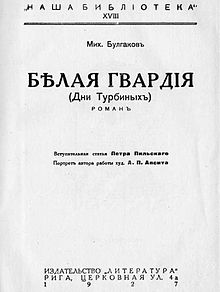The White Guard
 First émigré edition | |
| Author | Mikhail Bulgakov |
|---|---|
| Original title | Белая гвардия |
| Country | Soviet Union |
| Language | Russian |
| Publisher | Rossiya (serial) |
Publication date | 1925 |
Published in English | 1971 |
| Media type | |
The White Guard (Russian: Белая гвардия) is a novel by 20th-century Russian writer Mikhail Bulgakov, famed for his critically acclaimed later work The Master and Margarita.
Background[]
The White Guard first appeared in serial form in the Soviet-era literary journal Rossiya in 1925,[1] but the magazine was closed down before the serial was completed. It was not reprinted in Russia until 1966.
After the first two parts of The White Guard were published in Rossiya, Bulgakov was invited to write a version for the stage. He called the play The Days of the Turbins. This was produced at the Moscow Art Theatre, to great acclaim. According to some sources, Stalin saw it no fewer than 20 times.[1] In fact, the play completely overshadowed the book, which was in any event virtually unobtainable in any form.
Plot[]
Set in Ukraine, beginning in late 1918, the novel concerns the fate of the Turbin family as the various armies of the Ukrainian War of Independence – the Whites, the Reds, the Imperial German Army, and Ukrainian nationalists – fight over the city of Kyiv. Historical figures such as Pyotr Wrangel, Symon Petliura and Pavlo Skoropadsky appear as the Turbin family is caught up in the turbulent effects of the October Revolution.
The novel's characters belong to the sphere of Ukrainian and Russian intellectuals and officers. In the army of Hetman Pavlo Skoropadskyi they participate in the defense of Kyiv from the forces of Ukrainian Nationalists (led by Petliura) in December 1918. The character Mikhail Shpolyansky is modelled on Viktor Shklovsky.[2]
The novel contains many autobiographical elements. Bulgakov gave the younger Turbin brother some of the characteristics of his own younger brother. The description of the house of the Turbins is that of the house of the Bulgakov family in Kyiv. (Today it is preserved and operated as the Mikhail Bulgakov Museum).
English translations[]
Bulgakov's widow had The White Guard published in large part in the literary journal Moskva in 1966, at the end of the Khrushchev era. This was the basis for the English translation by Michael Glenny, first published in 1971. This lacks the dream flashback sections. In 2008 Yale University Press published a translation by Marian Schwartz of the complete novel, an edition which won an award.
- The White Guard, translated by Michael Glenny, London: Collins and Harvill Press, 1971. ISBN 0002619059.
- London: Harvill, 1996. Revised edition. ISBN 1860462189.
- White Guard, translated by Marian Schwartz, introduction by . New Haven: Yale University Press, 2008. ISBN 978-0-300-15145-9
- The White Guard, translated by Roger Cockrell. Richmond: Alma Classics, 2012. ISBN 978-1-84749-245-6.
References[]
- ^ Jump up to: a b Dobrenko, Evgeny: Introduction to Bulgakov, Mikhail 2008. White Guard. transl. Marian Schwartz, Yale University Press, p. xix. ISBN 978-0-300-15145-9
- ^ Bulgakov, Mikhail Afanasevich; Schwartz (translator), Marian (2008). Dobrenko, Evgeny (ed.). White guard. Yale University Press. ISBN 9780300148190.
External links[]
| Wikimedia Commons has media related to The White Guard. |
- The White Guard (full text in Russian), RU: Lib.
- The White Guard (in Russian and English), Get parallel translations.
- 1966 novels
- 1925 Russian novels
- Novels set during the Russian Civil War
- Soviet novels
- Novels by Mikhail Bulgakov
- Novels first published in serial form
- Works originally published in Russian magazines
- Works originally published in literary magazines
- Novels set in Ukraine
- Novels set in Kyiv